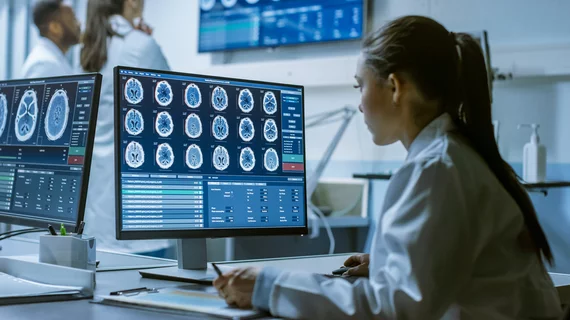Rising workloads spur academic radiologists to spend less time training residents
Rising reading workloads are spurring academic radiologists to spend less time training residents, according to new Neiman Health Policy Institute research published Tuesday.
Tracking the work of nearly 35,600 radiologists via Medicare claims demonstrated some notable trends, experts detailed in JACR [1]. The percentage of total clinical workload involving resident training fell from 35.3% in 2008 down to 26.3% in 2019. Meanwhile, radiologists’ aggregate workload increased by 80% during the same time span.
Lead author Judah Burns, MD, and colleagues are concerned this shift could impact the quality of educational efforts and harm the long-term sustainability of the academic workforce.
“Increasing volume has been a challenge in radiology departments, which provided impetus for this study. Anecdotally, the burgeoning workload appears to be a barrier for radiologists to engage in training residents, but no studies have evaluated these teaching trends with objective evidence,” Burns, vice chair of radiology education at Montefiore Medical Center in New York City, said in a statement. “Our national study shows a 19% drop in rate of cases read with a trainee among teaching radiologists, representing a significant and meaningful decrease.”
Neiman Health Policy Institute experts used Medicare’s GC modifier to identify billed services involving radiology trainee supervision. They also calculated each teaching radiologists’ total workload (quantified using billed work RVUs) and percentage that used trainee assistance.
Overall, the percentage of all U.S. radiologists involved in resident teaching increased from 13.6% in 2008 up to 20.4% in 2020. Meanwhile, among individual teaching rads, the percentage of their workload with trainee participation fell nearly 10 percentage points, down to 24.5% in 2020. Nationally, teaching radiologists’ average total workload increased 7% from 2008 to 2019 at a time when their teaching workload decreased 19%. This increase was absorbed at least partially by a uptick in radiologists who read cases with trainees. This number leapt from 20,530 in 2008 to 22,502 in 2020.
“This increase in workload could impact the time available to dedicate to teaching the next generation of radiologists and has additional implications regarding burnout,” senior author Andrew Rosenkranz, MD, director of health policy, Department of Radiology, at the NYU Grossman School of Medicine, said in the same statement.
The decline in trainee participation persisted across a spectrum of radiologist and practice characteristics, the authors noted. They believe their findings indicate that academic rads’ workloads are increasingly incorporating independent interpretation, while teaching represents a “diminishing component of their practices.”
Researchers speculated that these trends could be impacted by academic health center expansion, community practice consolidation and increasing subspecialization.
“Through such effects, the practice profile of teaching radiologists increasingly resembles that of radiologists in community practices,” the authors wrote. “Indeed, for teaching radiologists, increasingly independent work likely diminishes the unique differentiators that caused them to select academic over community practice. This shift could be augmenting burnout and adversely impacting job satisfaction and adversely impact the long-term sustainability of a robust academic radiologist workforce.”
Burns and colleagues also highlighted other notable trends that emerged from their data. Teaching radiologists are more often subspecialists who practice in urban settings compared to nonteaching peers. They also are more commonly women. Among teaching radiologists, the percentage of trainee participation decreased most substantially for cardiothoracic imaging subspecialists, rural rads, and those associated with a practice having 250-999 members.
Future research could explore how these trends impact the quality of education.
“Although our data does not include information about training effectiveness, the observed dispersion of training across a broader pool of radiologists, many of whom are doing very little training overall, indicates a need to evaluate change in quality and consistency,” YoonKyung Chung, PhD, principal policy researcher at the Neiman Institute, said in the same announcement. “While a subset (top 20%) of teaching radiologists is still doing a majority of their work with residents, this group has also demonstrated the largest drop in teaching workload, which is changing the training landscape.”
Read more, including potential study limitations, at the link below.

